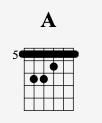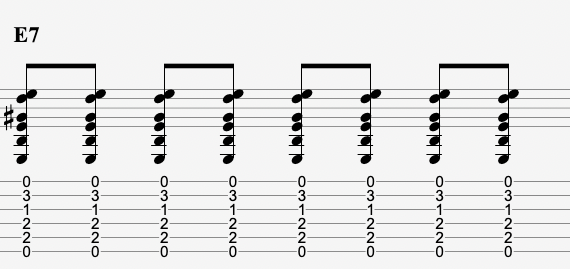Screamin’ Helter Skelter Chords & Guitar Lesson
True story:
I used to live in Box Canyon, where the psychopathic serial killer/cult leader Charles Manson used to hang out with his “Manson Family”.
Now, I lived there some 30 years later, things have changed quite a bit. I even recorded an album deep in the canyon. (Which you can listen to online called Songs From Box Canyon.)
But apparently Manson believed The Beatles’ had coded messages in their songs to him. Now what’s even scarier is I used to take little hikes out my back porch into the canyon when I lived in Box. And on one sunny day, I came around a bend and saw carved in a rock the words “Helter Skelter”.
I kid you not, it gave me the heebie jeebies.
However, the phrase "helter skelter" is a reference to a British amusement park slide, but Manson took it to mean impending doom and destruction.
So grab your 6-stringer, and let’s dive into this “Helter Skelter” chords and guitar lesson!
Who Wrote Helter Skelter?
“Helter Skelter” was primarily written by Paul McCartney although it’s credited to the Lennon/McCartney partnership. McCartney wrote it trying to create the loudest, rawest, and most intense rock song possible. He was inspired by an interview with Pete Townshend of The Who. In the interview, Townshend described the Who’s song “I Can See for Miles” as their heaviest, dirtiest ever. McCartney listened to it and thought, "That’s not so heavy!"—so he set out to write something even more aggressive and rocking.
It kicks off with this edgy double-stop riff that descends down chromatically. Which fits what the song is about – a British amusement park spiral slide. The song is literally about the ride—going up, spiraling down, and the excitement/chaos.
The final version of "Helter Skelter" was recorded at on September 9, 1968 at Abbey Road Studios in London. This is the same legendary studio where The Beatles made most of their albums.
Paul McCartney pushed for a heavier, faster, and dirtier sound. They cranked up their amps, distorted their guitars, and played at full volume.
Ringo Starr pounded the drums so hard that by the end of the take, his hands were literally bleeding. You can hear him scream at the end of the recording…
"I've got blisters on my fingers!"
The band recorded 18 takes before nailing the version we hear that went on famous Beatles album known as The White Album.
Paul McCartney still plays it live, in fact, his performances of "Helter Skelter" today are just as wild as ever!
Lunatic Manson took the song later and convinced his followers they needed to spark a war, which led to the infamous Tate-LaBianca murders in 1969. At the LaBianca crime scene, the words "Helter Skelter" were written in blood.
McCartney’s Response:
He was horrified that his song was linked to such violence. In later interviews, he said, "It was just about a fairground ride, man!"
Now, you may be wondering…
What is the tuning for Helter Skelter?
The tuning for "Helter Skelter”, as recorded by The Beatles, is standard tuning. The Beatles kept it simple.
Standard tuning for a guitar is spelled out as EADGBE.
Here are the strings:
- E (6th string, lowest pitch)
- A (5th string)
- D (4th string)
- G (3rd string)
- B (2nd string)
- E (1st string, highest pitch)
Next, let’s take a look at the…
Helter Skelter Chords
To play “Let It Be” on guitar you’ll only need to know 3 main chords they are E7, G, and A. I play these chords as a mix of open and closed position chords. Let’s take a look at a few ways the “Helter Skelter” chords can be played on the neck:
E7 is played using all 6 strings in open position like so:

G I play as a bar chord in 3rd position like this:

Finally, we have the A chord which is the same shape as the G chord just shifted up 2 frets like this:

If you’ve struggled to understand the fretboard for RHYTHM and LEAD guitar and want to discover the simplest way. Then get your hands on my free fretboard guide PDF right here now:
All right! Now that you know the "Helter Skelter” chords, let’s next talk about…
What key is Helter Skelter in?
"Helter Skelter" as recorded by The Beatles is in the key of E major. The chord progression, however, reflects a bluesy vibe.
In a typical E blues context, the three most common chords are:
- I7 (E7) → The tonic (home base)
- IV7 (A7) → The subdominant
- V7 (B7) → The dominant
But in "Helter Skelter", there's a G major instead of the usual B7.
How does G fit?
Well, G major (G - B - D) does NOT belong to E major (which has a G#)
But in a blues setting, we often mix major and minor tonalities—this is called a "bluesy parallel substitution" The G major chord is acting as a ♭III chord in the E mixolydian or E blues scale.
All together we have:
- I7 (E7) → The tonic (home base)
- ♭III (G) → Blue third
- IV (A) → The subdominant
So that’s the theory, next, let’s look at…
What is the strumming pattern for Helter Skelter?
The main underlying groove for “Helter Skelter” is a bashing 8th-note rock feel. In 4/4 time, 8th notes divide each beat into two equal parts, creating a driving, steady rhythm like this:
1 & 2 & 3 & 4 &
The numbers (1, 2, 3, 4) represent the main beats in the measure, while the "&" represents the offbeats that add energy and momentum.
When counted out loud, it sounds like:
"One-and, Two-and, Three-and, Four-and."
This gives a strong and consistent forward motion to the tune. Here’s an example of a “Helter Skelter” strumming pattern:

Helter Skelter Guitar Solo
The guitar solo was played by Paul McCartney and uses some chaotic bluesy bends and the blues scale.
Here’s an example of a lead guitar lick in this style:

Conclusion
There you have it – a quick breakdown of the guitar style used in “Helter Skelter” taught by a guy who lived in Box Canyon.
Keep practicing, and if you want to learn songs faster, better understand the fretboard, and not waste years spinning your wheels with guitar, grab my free fretboard guide PDF right here now:
Jon MacLennan
Like this blog post? Get Jon’s best guitar lessons straight to your inbox.
